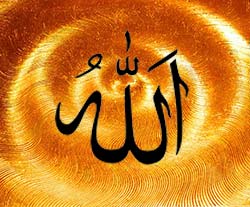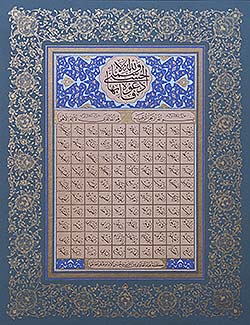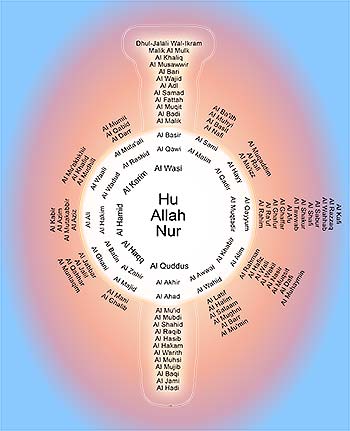Concepts in Sufism
 Allah says in a hadith qudsi (holy tradition, a saying attributed to, or anecdote regarding Prophet Muhammad [peace be upon him], according to traditional eyewitness accounts), “I created some of My servants for my zat (essence; person).” The Sufi’s goal in life is to achieve an intimate understanding of and love for God. Tasawwuf, known in the West as Sufism, is a process of attaining closeness to the Creator through love, which is attained by purification of the nafs (egoistic or animalistic nature). Such a loving relationship with Allah, held by many prophets and other saintly individuals throughout history, may be achieved by anyone who sincerely wishes for it and is willing to undertake the discipline necessary to achieve that state.
Allah says in a hadith qudsi (holy tradition, a saying attributed to, or anecdote regarding Prophet Muhammad [peace be upon him], according to traditional eyewitness accounts), “I created some of My servants for my zat (essence; person).” The Sufi’s goal in life is to achieve an intimate understanding of and love for God. Tasawwuf, known in the West as Sufism, is a process of attaining closeness to the Creator through love, which is attained by purification of the nafs (egoistic or animalistic nature). Such a loving relationship with Allah, held by many prophets and other saintly individuals throughout history, may be achieved by anyone who sincerely wishes for it and is willing to undertake the discipline necessary to achieve that state.
The underlying tenet of Sufism is that human beings were created to know Allah and to manifest His attributes while living on this earth. Tasawwuf is a method and way of life that enables one to become insan-i kamil, a true human being who has realized intimacy with his Creator. When his or her spiritual potential has been achieved, a human being is fit to be Allah’s khalifa (deputy) on earth, as Allah intended, according to the Holy Qur’an.

Every human being is equipped with the inner circuitry that joins him with the divine. Many experience moments of truth, when the circuits light up and knowledge of the absolute becomes manifest. While these times of heightened awareness may pass as quickly as they come, the method of tasawwuf is designed to enable the seeker to forge a pure and permanent connection, to gain eternal life while living on this earth.
The word “concepts” does not fully describe the topics treated here. A better description would be “facets of consciousness” that the student of Sufism experiences as he or she travels along the Sufi path. Many of the topics in this section of the website are excerpts from the book The Sun Will Rise in The West by Shaykh Taner Ansari. This book is recommended to readers for a detailed and comprehensive explanation of Sufism that is especially tailored to the Western mindset.
Please note that the use of the masculine pronouns in some of these writings is purely for convenience. The Sufi path is open to women and men alike. Likewise, there is no gender implication in the Arabic name “Allah.”
Allah From a Sufi Perspective

We call God “Allah” because there is no gender implied in this Arabic appellation. Allah can have no gender because that would be a limiting factor, and Allah can have no limits. We believe that God is omniscient, omnipotent, and is the uncaused Cause of all creation. Allah is without limit in every dimension, infinitely and eternally, the formless Creator of all forms. Allah is neither created nor can He be destroyed.
The one thing in the universe we know of that cannot be created or destroyed is energy. Energy can be understood as the capacity to do work, as the force that is behind all action, and as action itself. We know energy as a kind of light/force, as that which radiates and that which is radiated. It is both substance and movement. Sufis believe that Allah is the fundamental energy which has existed before all time, because Allah is both uncreated and the Creator. We understand Allah as the conscious energy of the universe, the One who contains infinite knowledge and power to act in whatever way He wills.
Allah defines Himself in the Holy Quran as “…the Light of the heavens and the earth” (24:35). Just as we understand that light is energy, we conceive of Allah as energy. Allah as pure energy is formless, but contains the potential to create all forms. Allah’s power is at once the energy used to create all forms, and the energy/substance of forms. For Sufis, Allah’s inherent quality of awareness, His comprehensive and eternal consciousness, is another aspect of the “Light” by which He describes Himself. There can be no god but Allah, because the existence of any other power would limit God, Who is without any limit whatsoever.

Allah is the Light of the heavens and the earth. The analogy of His light is as a niche, and within it, a lamp. The lamp is enclosed in a glass. The glass is like a shining star. Lit from a blessed tree, an olive neither of the East nor of the West, whose oil is almost luminous, though no fire touched it. Light upon light. Allah guides unto His light whom He will. And Allah speaks to mankind in allegories, and Allah is Knower of all things. (Qur’an 24:35)

With further investigation into the concept of Allah as energy, another notion emerges. If Allah is both the substance and the Creator of creation, there can be nothing else but Allah. There can be no place where Allah is not because that would imply that something outside of Allah exists. Thus, from the Sufi perpective, nothing exists but Allah.
The Beautiful Names of Allah

All creation consists of Allah’s own substance. The basic matter of all things is contained within His singular reality. Sufis call this spiritual/material substance the Ninety-Nine Names or the Beautiful Names of Allah. These names are Allah’s diverse attributes, all of which comprise His entire being. Allah’s essence holds all of these qualities as potential energy. In the act of creation, His potential energy becomes kinetic.
Most of Allah’s names are found in the Holy Qur’an, interspersed in its many suras [chapters]. Sufis see them as Allah’s way of describing Himself in the Qur’an, the Word of God revealed to Prophet Muhammad (peace be upon him). For Sufis, Allah’s names are the very stuff of creation, as well as the means by which Allah sustains it. The Beautiful Names, as compiled below, are understood by Sufis as a chart of universal elements, which supersedes the periodic table of chemical elements devised by scientists.

In a sacred tradition Allah told Prophet Muhammad (pbuh), “I was a secret treasure and I wished to be known, so I created creation.” Allah fashioned the universe or universes from His pure light. His energy existed in a formless state, and He willed the energy to take shape over time. In the act of creation Allah activated some of His inherent attributes, such as Al Khaliq, Al Bari, Al Musawwir. Allah began the creation with one word, “Be.” At that moment, the creation of the universe started.

The Big Bang theory of the origin of the universe corroborates the Sufi viewpoint. According to this theory, the universe came into being through a series of explosions. With each explosion a new chemical element was created. In Sufi terms, Allah’s light thus began taking shape in material form, and the interaction of Allah’s attributes produced variety and complexity. Waves, subatomic and atomic particles, molecules, cells, organisms, the development of all that exists began as energy and continues to exist as energy in various states of formation, from wave particles to the human being. For the Sufi, the universe has long been understood as a multilayered totality, light wrapped in sheaths of increasingly more dense matter.
Allah’s names are manifest in various combinations at each point of creation. The formula Allah used for each thing determines its unique character. This uniqueness itself is an expression of Allah’s name Al Ahad, The Unique. Because Allah’s intention was to be known, He created a being who could know Him intimately, as a living, conscious synthesis of all of His Beautiful Names. Allah designed only one creature to manifest all of His divine attributes. This fruit of the universe, the end product of the creation of the worlds, is the human being.
The Beautiful Names, which are Allah’s attributes, fall within His Mercy and/or Power sides, as depicted in this illustrated chart. The center line symbolizes the Balance Names of Allah. The inner circle represents the Zat Names of Allah. The Power Names of Allah are on the left and the Mercy Names of Allah are on the right.

- Allah: God
- Al Rahman: The One Who Acts with Mercy
- Al Rahim: The Source of Mercy
- Al Malik: The Ruler; The King; The Owner of the Dominion
- Al Quddus: The Holy One
- Al Salaam: The Peaceful One
- Al Mu’min: The Accepter of the Truth; The One Who Acts With the Truth
- Al Muhaymin: The Protector; The Guardian; The Giver of Security
- Al Aziz: The Mighty with Benevolence; The Revered One
- Al Jabbar: The Compeller
- Al Mutakabbir: The Possessor of Greatness
- Al Khaliq: The Creator
- Al Bari: The Shaper
- Al Musawwir: The Detailer
- Al Ghaffar: The Oft-Forgiving One
- Al Qahhar: The Overpowering One
- Al Wahhab: The Bestower
- Al Razzaq: The Provider
- Al Fattah: The Opener; The Presider
- Al Alim: The All-Knowing One
- Al Qabid: The Constrictor
- Al Basit: The Reliever; The Expander
- Al Khafid: the Abaser
- Al Rafi: The Exalter
- Al Mu’izz: The Bestower of Honors
- Al Mudhill: The Humiliator
- Al Sami: The Hearer
- Al Basir: The Seer
- Al Hakam: The Judge
- Al Adl: The Just One
- Al Tawwab: The Accepter of Repentance
- Al Latif: The Subtle and Kind One
- Al Khabir: The All-Aware One
- Al Halim: The Soft and Gentle One Who Gives Ease
- Al Azim: The Magnificent One
- Al Ghafur: The Purifying and Tolerant One Who Overlooks Sins
- Al Shakur: The Source of Gratitude
- Al Ali: The Exalted One
- Al Kabir: The Incomparably Great One
- Al Hafiz: The Preserver and Protector
- Al Muqit: The Caretaker
- Al Hasib: The One Who Keeps Accounts and Measures of All Things
- Al Jalil: The Mighty One
- Al Karim: The Generous One
- Al Raqib: The Vigilant Supervisor
- Al Mujib: The Responsive One
- Al Wasi: The All-Encompassing One
- Al Hakim: The Wise One
- Al Wadud: The Loving One
- Al Majid: The Glorious One
- Al Ba’ith: The Resurrector
- Al Shahid: The Witness
- Al Haqq: The Truth
- Al Wakil: The Trustee; The Representative; The Guardian
- Al Qawi: The Strong One
- Al Matin: The Enduring One
- Al Wali: The Protecting Friend
- Al Hamid: The One Who Deserves All Praise; The One Who is Glorified
- Al Muhsi: The Doer of Good
- Al Mubdi: The Originator
- Al Mu’id: The Restorer
- Al Muhyi: The One Who Is Able to Revive
- Al Mumit: The Giver of Death
- Al Hayy: The Alive, Continuously Existing One
- Al Qayyum: The Caretaker
- Al Wajid: The One Who Forms
- Al Majid: The Glorious One
- Al Wahid: The One and Only
- Al Ahad: The Unique
- Al Samad: the Receiver of Requests
- Al Qadir: The One Who Is Able to Do All Things
- Al Muqtadir: The Creator of All Power
- Al Muqaddim: The One Who Puts His Creatures Ahead
- Al Mu’akhkhir: The One Who Puts His Creatures Behind
- Al Awwal: The Former
- Al Akhir: The Latter
- Al Zahir: The Outer
- Al Batin: The Inner
- Al Waali: The Governor
- Al Muta’ali: The Highly Exalted One
- Al Barr: The Pure One
- Al Muntaqim: The Avenger
- Al Afu: The Forgiver
- Al Ra’uf: The Clement One; The One Full of Kindness
- Malik al Mulk: Owner of All
- Dhul-Jalali Wal-Ikram: The Lord of Majesty and Bounty
- Al Muqsit: The Equitable One
- Al Jami: The Gatherer
- Al Ghani: The Self-Sufficient One
- Al Mughni: The Enricher
- Al Mani: The Preventer
- Al Darr: The Creator of the Harmful
- Al Nafi: The Creator of Good
- Al Nur: The Light
- Al Hadi: The Guide
- Al Badi: The Originator
- Al Baqi: The One Who Remains
- Al Warith: The Inheritor
- Al Rashid: The One Capable of Right Judgment
- Al Sabur: The Patient One
Prophet Muhammad as the Sufi’s Model

In the tradition of Sufism Muhammad (peace be upon him) is respected as the prototypical example of a true human being. Sufis strive to emulate his behavior in the hope of attaining a similar close and loving relationship with the Creator.
We sent thee (O Muhammad) not except as a mercy for all creatures. (Qur’an 21:107)
Allah designated certain persons as His prophets, to be living repositories of direct knowledge from Him. As Allah’s representatives on earth, the prophets (peace be upon them all) were obliged to consistently affirm the reality of the all-embracing dominion of Allah. They were sent as warners to people whose customs deviated from divinely prescribed behavior, in order to reinforce a sanctified relationship between God and mankind. The main vehicle for this sacred connection was the covenant, the ageless pact wherein human beings acknowledge the sovereignty of their Lord, who in turn reciprocates with His promise of divine guidance and protection. Allah established this spiritual contract in human society with Adam (pbuh), whom He appointed as His first prophet. The divine covenant was subsequently renewed under the leadership of the prophets who succeeded Adam (pbuh) throughout the course of human spiritual development.
Mankind was one community. Then Allah sent prophets as bearers of good news and as warners, and sent down with them the scripture with the truth that it might judge between human beings concerning the subjects in which they differed. (Qur’an 2:213)

All of the prophets attained high degrees of virtuous traits commensurate with the needs of their people. The knowledge they transmitted was designed to be reflected in their living example. The station of prophethood reached maturity in Muhammad (pbuh).
Muhammad is not the father of any one among you men, but he is the Messenger of Allah and the Seal of the Prophets; most definitely, Allah knows everything. (Qur’an 33:40)
 The perfect rendering of Allah’s knowledge in the Qur’an finds its living example in the last Prophet (pbuh), who exemplifies the ideal inner and outer reality of the human being. Muhammad (pbuh) fully actualizes the outer form and the inner content of the knowledge of Himself that Allah chose to impart to man. All of the virtuous traits which Allah encourages humans to strive to attain are contained within his being. In other words, Muhammad (pbuh) is the Qur’an. His reality is the synthesis of Ilm al Yaqin, knowledge through communication, ‘Ayn al Yaqin, knowledge through experience, and Haqq al Yaqin, knowledge through direct communion with Allah, the complete scope of Allah’s greatest favor to us, which is insight into the ultimate truth.
The perfect rendering of Allah’s knowledge in the Qur’an finds its living example in the last Prophet (pbuh), who exemplifies the ideal inner and outer reality of the human being. Muhammad (pbuh) fully actualizes the outer form and the inner content of the knowledge of Himself that Allah chose to impart to man. All of the virtuous traits which Allah encourages humans to strive to attain are contained within his being. In other words, Muhammad (pbuh) is the Qur’an. His reality is the synthesis of Ilm al Yaqin, knowledge through communication, ‘Ayn al Yaqin, knowledge through experience, and Haqq al Yaqin, knowledge through direct communion with Allah, the complete scope of Allah’s greatest favor to us, which is insight into the ultimate truth.
Today have I perfected your din (way of life; religion; path of righteousness to Allah) for you, completed My favor upon you, and have chosen for you Islam (surrender; submission) as your din. (Qur’an 5:3)
In Muhammad (pbuh), the circle of human development is completed. From His face, His essence, Allah created the Light of Muhammad, which is the spiritual essence of all believers. Allah reinforced the earthly manifestation of His light continuously throughout the history of mankind by sending a succession of prophets to help secure the truth within the hearts of believers. The light-circuit was clinched with the arrival of Muhammad (pbuh) in physical form on the earth, as he was the material manifestation of the primordial energy with which Allah chose to grace the human being. Muhammad (pbuh) exemplifies the spiritual knowledge and demeanor of insan-i-kamil, the perfected human being. He is both the prototype and the ultimate actualization of the human model that Allah had in mind at the outset of creation.
The Sufi Way of Love
 The believer who yearns for something deeper than the promised reward of eternal salvation for good behavior is faced with a challenge which springs from within. Happiness for him is not achieved by clinging to the hope of endless delights in Paradise, nor is he motivated toward being good in order to avoid the agonies of hell. Consciously or unconsciously, this seeker is after absolute truth. It is the inner man who remembers when he was not separated from his Lord, and now longs to be reunited with his true Beloved. Although in fact no real dichotomy exists, the mind learned to create a separate entity of itself, wrapped up in human flesh, when the self was born. This seeker craves for the conscious realization of what his heart already knows – that he is connected very intimately with the essence of Allah, and in fact his true nature lies in the experience of knowing that ultimate reality. The task at hand thus becomes to discover where his “self” fits in relation to Allah’s unlimited Being.
The believer who yearns for something deeper than the promised reward of eternal salvation for good behavior is faced with a challenge which springs from within. Happiness for him is not achieved by clinging to the hope of endless delights in Paradise, nor is he motivated toward being good in order to avoid the agonies of hell. Consciously or unconsciously, this seeker is after absolute truth. It is the inner man who remembers when he was not separated from his Lord, and now longs to be reunited with his true Beloved. Although in fact no real dichotomy exists, the mind learned to create a separate entity of itself, wrapped up in human flesh, when the self was born. This seeker craves for the conscious realization of what his heart already knows – that he is connected very intimately with the essence of Allah, and in fact his true nature lies in the experience of knowing that ultimate reality. The task at hand thus becomes to discover where his “self” fits in relation to Allah’s unlimited Being.
As for those who strive for Us, We will definitely guide them to Our paths and (then surely you will see that) Allah is with the doers of good. (Qur’an 29:69)
According to a Sufi saying, “Heart is the sultan,” because that is where Allah makes His presence known in the human being. Love is the medium of unity, the process through which the electromagnetic vibrations produced by the heart and mind are working in tandem, thereby setting up the optimum scenario for spiritual learning. Tasawwuf, known in the West as Sufism, is the process through which Allah, through the shaykh, clears the path into the depths of the seeker’s heart, which is the seat of divine union, and therefore the “house” of God.

The human being’s conscience is the voice of the ruh (spirit; soul) making itself heard in his heart. For the Sufi, expanding one’s consciousness means directing his or her attention to the wisdom of the heart, because knowledge from Allah is broadcast to that center of his being. The goal of tasawwuf training is to be able to hear Allah’s voice in the heart, and for a loving relationship with Allah to develop in that site of spiritual interchange. The mature human being makes his choices based on the information housed therein, using his aql (rational mind; intellect) as the arbiter of messages and information that come through. Many notions may spring up, but it takes a mature human being to be able to differentiate among them and recognize the sources of such communications.
In the material world of proofs, Allah has made moral distinctions for human beings so that they can choose good and avoid evil. The wisdom on which good action is based is learned in three ways: by hearing of or reading about universal truths, by observing these truths in action or experience, and directly from Allah. It is Allah within that the Sufi strives to touch. Sufis wish to be with Allah in the same intimate way that lovers are united. All of creation serves Allah, willingly or unwillingly. Sufis wish to serve Allah willingly, knowingly, and lovingly. That is why Sufism is called the way of the heart, designed to bring the human being to his ultimate objective of loving intimacy with Allah.
 When the heart is clean, the inner spiritual senses come alive to balance the outer senses. The mature Sufi’s heart has become identified with Muhammad’s (peace be upon him) heart, which is in constant rapport with the essence of Allah. It is aligned with Allah and the entire universe, and has, in a sense, become the universe. Through such a heart Allah sends His mercy to creation. The Sufi functions as a servant of Allah in this material world in an active way, through beneficial action, and in a passive way, as a conduit for Allah’s mercy. In this way the Sufi is said to follow in the footsteps of Muhammad (pbuh).
When the heart is clean, the inner spiritual senses come alive to balance the outer senses. The mature Sufi’s heart has become identified with Muhammad’s (peace be upon him) heart, which is in constant rapport with the essence of Allah. It is aligned with Allah and the entire universe, and has, in a sense, become the universe. Through such a heart Allah sends His mercy to creation. The Sufi functions as a servant of Allah in this material world in an active way, through beneficial action, and in a passive way, as a conduit for Allah’s mercy. In this way the Sufi is said to follow in the footsteps of Muhammad (pbuh).
Nafs – The Enemy Within
 The human being is a walking laboratory designed for the purpose of observing and understanding Allah, who created him from the lowest of the low to the highest of the high. Man’s animal nature, comprised of bodily functions and egoistic desires, is known as the nafs. The nafs is tied to the material world, and is therefore restricted by the temporary quality of all creation. The perspective from which the nafs perceives reality is itself. This self-biased aspect of the human being is part of the triad which describes him more thoroughly. For the purpose of simplification, nafs can be thought of as the outer man, ruh (soul; spirit) as the inner man, and aql, the composite faculties of rational discrimination and decision-making, as the bridge between the two.
The human being is a walking laboratory designed for the purpose of observing and understanding Allah, who created him from the lowest of the low to the highest of the high. Man’s animal nature, comprised of bodily functions and egoistic desires, is known as the nafs. The nafs is tied to the material world, and is therefore restricted by the temporary quality of all creation. The perspective from which the nafs perceives reality is itself. This self-biased aspect of the human being is part of the triad which describes him more thoroughly. For the purpose of simplification, nafs can be thought of as the outer man, ruh (soul; spirit) as the inner man, and aql, the composite faculties of rational discrimination and decision-making, as the bridge between the two.
The basic motivation of the nafs is survival, self-preservation. This inherent urge to stay alive and reproduce itself colors its behavior. Void of wisdom, the nafs is prone to conduct itself on a reactive basis, as higher knowledge is not within the realm of its operation. Although he has an animal nature, man is distinguished from and considered a higher being than an animal because of his rational and spiritual capacity, even though his actions far too often do not reflect that capacity.
Prophet Muhammad (peace be upon him) said, “If you know your nafs, you know Allah.” Once we have learned to identify the ways of nafs within ourselves, we have gained a perspective from which to distinguish between selfish desires and the wishes of Allah. From this basis we may choose actions motivated by the desire to please Allah. A Sufi constantly strives to know whether his actions please Allah or his nafs.

In traditional Sufi lore nafs is likened to a donkey. The Sufi asks him- or herself: Am I riding the donkey, or is the donkey riding me? The method of Sufism is designed to help the murid, a student of Sufism, identify his nafs so that he can conquer it. The point is for the murid to gain control over the nafs, so that his or her actions and thoughts are Allah-based and not self-centered. When he succeeds, he achieves the optimum balance between his outer, material, self and his inner, spiritual, one. The Sufi’s intention is to be in a continuous state of vigilance vis-a-vis his own nafs. In that way, he proves to Allah that he is choosing Him and not nafs. For example, nafs might incite him to cheat on an exam in school, but when he chooses not to cheat he has shown Allah that His pleasure with his actions is more important to him than any temporary benefit derived from cheating. Having nafs is a natural and necessary part of the human condition; having one’s nafs under control is the condition of the insan-i-kamil (mature human being).
 The intensity of the struggle with his nafs’ desires is the standard Allah uses to judge man and reward his efforts with closeness to Him. The more choices made for Allah’s sake, the closer man comes to knowing Allah. In exercising his free will in the right way, he learns to fulfill his destiny as a human being, to be a knower of Allah, His deputy, and, finally, His lover.
The intensity of the struggle with his nafs’ desires is the standard Allah uses to judge man and reward his efforts with closeness to Him. The more choices made for Allah’s sake, the closer man comes to knowing Allah. In exercising his free will in the right way, he learns to fulfill his destiny as a human being, to be a knower of Allah, His deputy, and, finally, His lover.
Life in the world can be seen as a long series of creating nafs-attachments, as our desires and expectations grow along with us. The Sufi murid quickly learns the considerable magnitude of his attachments, and the seemingly endless ways he has learned to put his trust in other than Allah. He realizes that he himself is the idol that must be broken in surrendering to the true God.
The nafs is a very stubborn idol, prone as it is toward self-preservation. Any attempt at tampering with its long-cherished habits is naturally met with extreme resistance. Therefore, in tasawwuf different apects of the nafs are tackled in sequence, starting from the roughest and most obvious, to the more subtle characteristics.
The nafs is separated into seven levels, a divide-and-conquer tactic, so that the murid can detach himself by degrees from its influence. With each level of cleansing, the murid moves another step closer to unity with Allah, with the shaykh’s permission, as he holds the key to his student’s promotion through the levels of nafs. Every level bids a specific practice, which the shaykh usually changes when he knows that his student is ready to move on.
And We have created above you seven tariqas (paths) and We are fully aware of and know what We are creating and making. (Qur’an 23:17)
1. Nafs-i-Ammara: The Dominant Nafs
Traits: narcissistic, mechanical, conditioned, non-reflective, impulsive
Habits: pride, enmity, cruelty, lust, stinginess
There is no doubt that nafs-i-ammara (the dominant nafs) orders us to do evil, except those on whom my Lord has mercy. (12:53)
2. Nafs-i-Lawwama: The Blaming Nafs
Traits: conscience, capacity for self-observation
Habits: backbiting, trickery, conceitedness, hypocrisy, self-consciousness, guilt, fearfulness, wishful thinking, intense desire to please others
But I swear by the nafs-i-lawwama (blaming nafs) (that this Scripture is true). (75:2)
3. Nafs-i-Mulhama: The Inspired Nafs
Traits: generosity, gratitude, modesty, empathy, ardent desire
Habits: liberality lacking discrimination, mystical inflation, tendency toward spiritual greed
And a nafs and Him who gave order to it and inspired it with a sense of what is wrong for it and (what is) right for it. (91:7-8)
4. Nafs-i-Mutmaina: The Tranquil Nafs
Traits: dignity, sincerity, courage, compassion, complete loyalty
Habits: Attachment to spiritual ambition
O, you nafs at peace! (89:27)
5. Nafs-i-Radziyya: The Satisfied Nafs
Traits: endurance, resignation, constancy
Habits: personal identification with affliction
Return to your Lord, content… (89:28)
6. Nafs-i-Mardziyya: The Satisfying Nafs
Traits: knowledge of God, sincerity, unbounded faith and hope in existential communion
Habits: mystical intoxication, lack of sobriety and balance
…for His being pleased with you! (89:28)
7. Nafs-i-Safiyya: The Purified Nafs
Traits: freedom from duality, acceptance of God’s will, joy of union, freedom from expectation, contentment
Habits: None remaining
Today I have perfected your din (way of life; religion; path of righteousness to Allah) for you and have completed my favor to you and have chosen Islam (surrender; submission) for you as a din. (5:3)
As the murid moves through the levels of nafs, he or she is learning ever deeper levels of surrender by detachment from the mire of personal desires. Tasawwuf is a process of constant surrender, through which one puts nafs in its proper place, which is away from the heart, the sultan, within. If the murid chooses not to proceed and stops at any level, this becomes his maqam, or permanent station. The insan-i-kamil (mature human being) has surrendered to Allah completely, having become complete master over his nafs. Detached from himself, he has strengthened His attachment to Allah in body, mind, and soul. Born with the capability of becoming the lowest of creatures, one who is dominated by his nafs’ selfish inclinations, in defeating the nafs he or she has attained a station higher than the angels. For him the nafs has been transformed into an agent of spiritual advancement.
The Role of the Shaykh
 Every true shaykh has been appointed to the task of teaching tasawwuf, known in the West as Sufism, by his own shaykh, who was previously assigned by his shaykh, and so on, in a line that stretches back to Prophet Muhammad (peace be upon him). Each of the several schools, or tariqas, of Sufism, is thus supported by its own ancestral lineage of spiritual teachers, called silsila. Every silsila is documented in writing, and each line of descent, though distinct, proceeds from the authoritative decree of Prophet Muhammad (pbuh). In the act of initiation into a Sufi tariqa, the murid (Sufi student) makes spiritual connection not only with his own shaykh, but with the entire chain of shaykhs within the Sufi order to which his shaykh belongs. In taking hand with all of his shaykh’s spiritual ancestors, the murid makes a bond ultimately with the Prophet (pbuh) himself. This connecting with his silsila is what Sufis regard as “holding onto the rope” of Allah.
Every true shaykh has been appointed to the task of teaching tasawwuf, known in the West as Sufism, by his own shaykh, who was previously assigned by his shaykh, and so on, in a line that stretches back to Prophet Muhammad (peace be upon him). Each of the several schools, or tariqas, of Sufism, is thus supported by its own ancestral lineage of spiritual teachers, called silsila. Every silsila is documented in writing, and each line of descent, though distinct, proceeds from the authoritative decree of Prophet Muhammad (pbuh). In the act of initiation into a Sufi tariqa, the murid (Sufi student) makes spiritual connection not only with his own shaykh, but with the entire chain of shaykhs within the Sufi order to which his shaykh belongs. In taking hand with all of his shaykh’s spiritual ancestors, the murid makes a bond ultimately with the Prophet (pbuh) himself. This connecting with his silsila is what Sufis regard as “holding onto the rope” of Allah.
And hold tight to the rope of (connection to) Allah altogether, and do not be divided, and remember Allah’s grace to you when you were enemies. He brought your hearts together, so that you became like brothers with His grace, and when you were upon the edge of the pit of fire and He saved you from it. This is how Allah shows His ayats (revelations) to you clearly, so perhaps you will be among those (who choose to be) guided. (Qur’an 3:103)

The shaykh’s job is to help his murid reach the realization of Allah within himself and to protect him from spiritual danger. As tariqa is the bridge between the inner and outer worlds, the shaykh is the conductor who leads the way across, a living link between outer and inner. He has his feet in both worlds at all times, having been to the other side and sent back, in order to guide his children to their spiritual destination. The shaykh is a wali (protecting friend; saint) working visibly in the world, receiving guidance from his pirs (spiritual ancestors in the silsila) in the unseen.
None will have any power of intercession, except the one who has taken a covenant with Al Rahman (The One Who Acts with Mercy). (19:87)
Our Pir, Shaykh Abdul Qadir Geylani said:
In the hadiths (traditions; sayings attributed to, or anecdotes regarding Prophet Muhammad (pbuh), according to traditional eyewitness accounts) it is seen that the Prophet (pbuh) took a word from his sahabe (companions) that they were going to obey Allah. Thus taking one’s word, i.e., biat (making a pact), is modeled after such occasions, and is what makes it legal.
 The shaykh must have reached an advanced state of inner development to be an effective guide on the path of tasawwuf. In order for him to lead his murid to connection with his inner self, the shaykh must have traversed this territory himself, as it is otherwise impossible to show the way.
The shaykh must have reached an advanced state of inner development to be an effective guide on the path of tasawwuf. In order for him to lead his murid to connection with his inner self, the shaykh must have traversed this territory himself, as it is otherwise impossible to show the way.
The inner evolution of the shaykh has brought him through the four doors of tasawwuf: from sharia, which is what Muhammad (pbuh) said, through tariqa, what Muhammad (pbuh) did, through haqiqa, the secret of Muhammad (pbuh), to the state of marifa, the being of Muhammad (pbuh). The mature shaykh has been to the very core of being, at one with the essence of Allah, and back again, upon Allah’s command through His Prophet Muhammad (pbuh), to lead his children to that promised land. He is the point in which all of the pertinent knowledge is gathered, the interface between the seen and the unseen.
The conditions of a true shaykh are the following:
1) He follows the sharia.
2) He speaks about what is in your heart, and answers questions that you have not spoken aloud.
3) When you are in his presence, you forget your troubles, as he takes your load.
4) He praises Allah and not himself.
5) He has a silsila and ijaza (license) to teach the path.
Praise Allah Only But Respect the Shaykh
by Shaykh Taner Ansari
One must follow certain principles in order to attain closeness to Allah. A student’s relationship with his or her teacher is very important in this regard. Shaykh is not your friend. Shaykh is an employee of Allah who is helping you to have a relationship with Allah. It is your job to respect the door or the means through which you are getting Allah’s knowledge. The critical point is this: It is Allah who is teaching you through the shaykh; you have to remember this. Your biat (initiation) is to Allah, your focus is on Allah, your target is Allah, your beloved is Allah, what you yearn for is Allah; don’t forget this. All praise is due to Allah, as is mentioned in sura Al Fatiha (the first chapter of the Qur’an). Some people praise their shaykh because they are told Allah’s light is shining through their shaykh’s face. Seeing this yourself is one thing and being told that this is so is another thing. You have to act according to your own spiritual level. Otherwise, you can fall into shirk (associating partners with Allah). Even if you see Allah’s light in your shaykh, your job is to praise Allah, no matter what. As Allah The Most High says in the Holy Qur’an: “Look at the sun, but adore Allah who created it.” So don’t go too far in praising your shaykh, just respect him or her. Simple titles are sufficient. No shaykhs praise themselves, no prophets praise themselves; they all praise Allah. Why don’t we all do that?
Hz. Abdul Qadir Geylani on the Character of a Shaykh
Unless a shaykh attains the following twelve virtues in himself, he cannot sit on the sajada (prayer rug) of annihilation and wear the sword of being a helper. Two virtues are from Allah, two are from the Prophet (peace be upon him), two are from Abu Bakr, two are from Umar, two are from Osman, and two are from Ali, may Allah be happy with all of them.
The ones from Allah are: sattar (covering of shame or shortcomings), and ghaffar (forgiving much).
The ones from the Prophet are: shafiq (extreme kindness, mercy), and rafiq (extreme softness).
The ones from Abu Bakr are: sadiq (loyalty), and mutasaddiq (much alms giving).
The ones from Umar are: amri maruf (strongly enforcing right action), and nahy-i-munkar (forbidding ill deeds).
The ones from Osman are: mitam (hospitality), and musalli (praying during the night when everyone else is sleeping).
The ones from Ali are: alim (knowing), and shuja (courage).
If a shaykh doesn’t have the following five virtues, he will be a dajjal (misleader) who will lead the people into ignorance:
1. Outwardly, he should know sharia.
2. Inwardly, he should be researching haqiqa (the state of knowledge of the truth).
3. He has to serve his guests with a smiling face.
4. He must treat the poor kindly, saying nice words to them. This is the praised shaykh, who knows haram (what is forbidden) and halal (what is permitted).
5. He knows how to tame his own nafs (egoistic or animalistic nature) and how to tame the nafs of the wayfarers to haqiqa.
The person who is going to be a shaykh has to know the religious and natural sciences, and the terminology of the Sufi masters. If he does not know these, he cannot be a murshid (master). Junaid, may Allah be pleased with him, says, “Our knowledge depends on the Book of Allah (Qur’an) and sunna (observed behavior) of the Prophet. The one who does not memorize the hadith (sayings attributed to, or anecdotes regarding Prophet Muhammad [pbuh], according to traditional eyewitness accounts) and write it, who does not know the great Book and the terminology of the Sufi masters, who does not have any knowledge of the religion, is not a person among the ones who do irshad (teach enlightenment). As for me, the person who takes the responsibility of training and raising the murid must do this for Allah’s sake, not for his nafs (ego). When he is raising him, and inviting him to fight against his nafs, he must be kind, caring, and soft, as a father and mother treat their children. First, he has to show him the easy ways, and not give him or her a load he cannot carry. After he takes a word from him that he is going to leave his ill deeds and start praising Allah, then he can slowly, step by step, give him heavier assignments.
The person who wants to train himself without a shaykh is actually trying to raise a building without a foundation. A person who is not raised by masters, and did not get sacred milk from them, is like a child left in the middle of the street. If a person does not wear the clothing of taqwa (self-vigilance) in the hands of an alert and authoritative master, he will fall into the trap of his nafs, and his nafs will play with him as it wants, and it will lower him to baseness. On the other hand, the one who holds a strong handle will be able to see the secret of his existence, and he will be submersed into endless favors and pleasures of Allah. The murid who follows his nafs and who does not listen to his shaykh is really denying himself his portion in life.
Understanding Sufi Tariqas
 All true Sufi tariqas have a lineage that is traceable to Prophet Muhammad (peace be upon him) through his son-in-law Hazreti Ali (may Allah be pleased with him) or Hz. Abu Bakr (may Allah be pleased with him). According to hadith (tradition; saying attributed to, or anecdote regarding Prophet Muhammad [pbuh], according to traditional eyewitness accounts) the Prophet (pbuh) taught these esteemed individuals how to do zikr (the Sufi practice of repeating the Names of Allah) in two different ways. These methods were passed down through generations and are the foundation upon which the Sufi tariqas were later established.
All true Sufi tariqas have a lineage that is traceable to Prophet Muhammad (peace be upon him) through his son-in-law Hazreti Ali (may Allah be pleased with him) or Hz. Abu Bakr (may Allah be pleased with him). According to hadith (tradition; saying attributed to, or anecdote regarding Prophet Muhammad [pbuh], according to traditional eyewitness accounts) the Prophet (pbuh) taught these esteemed individuals how to do zikr (the Sufi practice of repeating the Names of Allah) in two different ways. These methods were passed down through generations and are the foundation upon which the Sufi tariqas were later established.

The various Sufi tariqas (Sufi orders; literally, paths) were established by their founders in response to the needs of different kinds of people. If a person is drawn to a particular school of Sufism, such as the Qadiri Tariqa or Mevlevi Tariqa, it is because that school has a flavor or character that addresses the particular needs of that individual. This can be thought of in the same light as vocational schools. If a person has a deep desire to become a chef of Chinese cuisine, he does not go to a master of French cuisine for training. Likewise, each spiritual seeker has a particular character that can be well served by a tariqa suited to his or her personality.
 The shaykhs of the path have been assigned an area of work and they may only accept the people who belong to them. While everyone is welcomed as a guest, it is understood that a true shaykh will recognize the people who belong to him or her and can only accept his or her own spiritual “children” as murids (students of Sufism; lit., committed ones). The shaykhs understand that their tariqa is “best” only for those people who Allah sends to them, and that no one, besides Allah, can be all things to all people.
The shaykhs of the path have been assigned an area of work and they may only accept the people who belong to them. While everyone is welcomed as a guest, it is understood that a true shaykh will recognize the people who belong to him or her and can only accept his or her own spiritual “children” as murids (students of Sufism; lit., committed ones). The shaykhs understand that their tariqa is “best” only for those people who Allah sends to them, and that no one, besides Allah, can be all things to all people.
Among the true tariqas there is general agreement about the essential tenets of Sufism. There is no competition among the tariqas. No tariqa claims that they have the one true way, or that it is higher than other orders.
